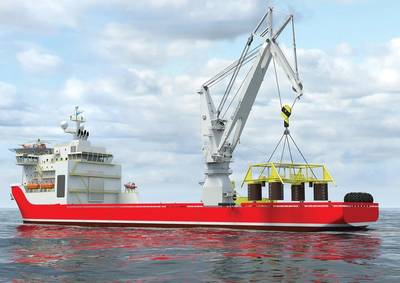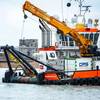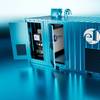Huisman Debuts Rope Luffing Knuckle Boom Crane
In order to provide reliable solutions for subsea installation in increasingly deeper water and offshore construction in severe weather conditions, Huisman introduces a new patented crane type during this year’s OTC: the ‘Rope Luffing Knuckle Boom Crane’. These new active heave compensated (AHC) cranes provide unparalleled performance by combining the benefits of a normal Rope Luffing Crane and a traditional Knuckle Boom Crane. As such it offers a high lifting height and a large capacity at outreach. The main hoist system, the patented anti-twist device, and the electric drive system really set these cranes apart from other cranes in the market. The capacities of the new cranes range from 400 up to 1,200 ton and up to 5,000 meter water depth. The first crane of this type, a 900 ton Rope Luffing Knuckle Boom Crane for Subsea 7’s ‘Seven Arctic’, is scheduled for delivery in 2016. A model of this vessel including the crane will be presented at the OTC Huisman booth, no. 2327.
For the innovative and patented design proven key components are used. By combining these components the overall construction weight of the crane can be kept low, whilst allowing for a high lifting capacity and large lifting radius. By incorporating a knuckle in the design of the crane it is possible to reduce the pendulum of the hook and, if extended, it can allow for high lifting heights. Furthermore, the boom of the crane can be stored vertically saving valuable deck space. The main hoisting system comprises a traction and storage winch system and a separate heave compensation system. This means both lifting/lowering and heave compensation can occur simultaneously with no performance interdependency, resulting in a better overall system performance and increased safety. A failure in main hoisting system will not affect the heave compensator or the other way around.
Because the crane is fully electrically driven, the power consumption, noise levels, and the number of components are reduced. This makes the crane more reliable than hydraulically driven cranes. It also means that maintenance and operational costs are reduced. The main hoist system can be equipped with a double fall reeve system instead of a single fall reeve system, improving the life span of the wire and therewith reducing operational expenditure. Further the lifetime of the wire rope is significantly extended by the combined active and passive heave compensation system on the main hoist, since the number of sheave bends is minimized and there is no drum crushing or wire rope cut-ins on the winch. The passive mode of the heave system includes built-in redundancy, so the passive system is fail-safe. During splash zone lifts, substantial reduction of the dynamic forces on the crane and the lifted object is achieved by using the passive system as a shock absorber, and can be used to avoid any resonance during subsea lifts. Furthermore, real-time active heave compensation can take place at a very low power consumption level. The anti-twist device prevents twisting of the lower block and wire rope during subsea lifts in double fall configuration. In addition, it lowers the point of application of the wire rope, which improves the stability of the vessel and reduces the boom tip motion.












